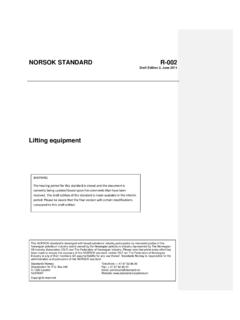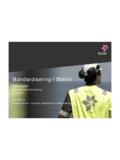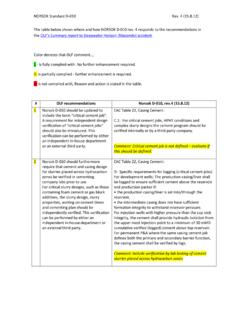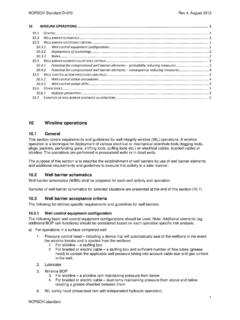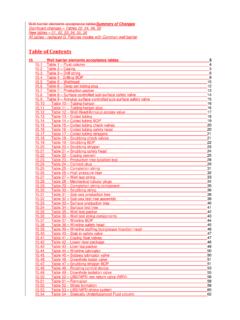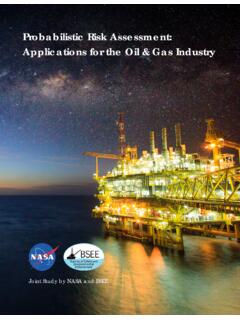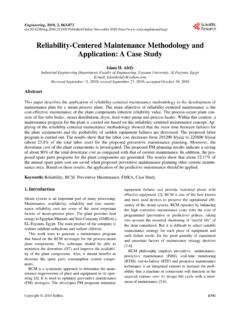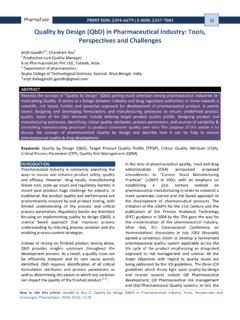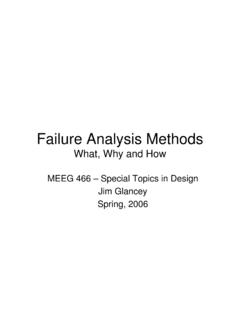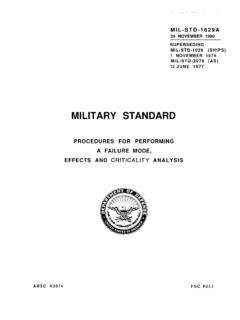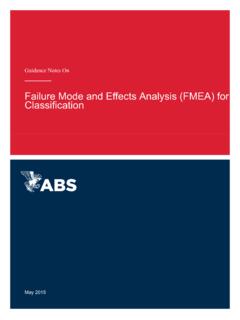Transcription of NORSOK STANDARD Z-008
1 This NORSOK STANDARD is developed by NTS with broad industry participation. Please note that whilst every efforthas been made to ensure the accuracy of this STANDARD , neither OLF nor TBL or any of their members will assumeliability for any use thereof. NTS is responsible for the administration and publication of this Technology CentreTelephone: + 47 22 59 01 00 Oscarsgt. 20, Postbox 7072 MajorstuenFax: + 47 22 59 01 29N-0306 OsloEmail: reservedNORSOK STANDARDZ-008 Rev. 2, Nov. 2001 criticality analysis for maintenance purposesNORSOK STANDARD Z-008 Rev. 2, Nov. 2001 NORSOK standardPage 1 of 30 Foreword2 Introduction21 Scope32 Normative references33 Definitions and of this NORSOK for risk evaluation and allocation of maintenance critical of static process equipment85 Functional hierarchy and criticality function (MF) function definition126 Documentation of the end product137 Application of criticality parts and design work orders18 Annex A (informative) Main function description and boundaries19 Annex B (informative) Simplifying consequence assessment23 Annex C (informative) Practical examples25 Annex D (informative) Relations to other NORSOK standards29 Bibliography30 NORSOK STANDARD Z-008 Rev.
2 2, Nov. 2001 NORSOK standardPage 2 of 30 ForewordThe NORSOK standards are developed by the Norwegian petroleum industry to ensure adequate safety,value adding and cost effectiveness for existing and future petroleum industry NORSOK standards are prepared to complement available international standards and fill the broadneeds of the Norwegian petroleum industry. Where relevant NORSOK standards will be used to provide theNorwegian industry input to the international standardisation process. Subject to development andpublication of international standards , the relevant NORSOK STANDARD will be NORSOK standards are developed according to the consensus principle generally applicable formost standards work and according to established procedures defined in NORSOK A-001 The preparation and publication of the NORSOK standards is supported by OLF (The Norwegian OilIndustry Association) and TBL (Federation of Norwegian Manufacturing Industries). NORSOK standards areadministered and issued by NTS (Norwegian Technology Centre).
3 All annexes are purpose of this NORSOK STANDARD is to provide requirements and guidelines for establishing a basis forpreparation and optimisation of maintenance programs for new and in service facilities offshore and onshoretaking into account risks related to: Personnel Environment Production loss. Direct economical cost (everything other than cost of production loss).The result of this NORSOK STANDARD is applicable for different purposes such as: Design initial maintenance manning requirements, identify hidden failures on critical equipment andselection of insurance spare parts. Preparation for of initial maintenance programs for implementation into maintenance managementsystems and selection of ordinary spare parts. Operational of existing maintenance programs and as a guide for prioritising work STANDARD Z-008 Rev. 2, Nov. 2001 NORSOK standardPage 3 of 301 ScopeThis NORSOK STANDARD is applicable for preparation and optimisation of maintenance programs for plantsystems and equipment including: Offshore topside systems.
4 Sub-sea production systems. Oil and gas systems involving the following types of equipment: Mechanical equipment. Static and rotating equipment. Instrumentation Electrical from the scope of this NORSOK STANDARD are: Load bearing structures. Floating structures. Risers and principle, all types of fault modes and failure mechanisms are covered by this NORSOK NORSOK STANDARD covers: Definition of relevant nomenclature. Guidelines for criticality analysis , including: Functional breakdown of plants and plant systems in main functions and sub functions. Identification of main function and sub function redundancy. Definition of failure consequence classes. Assessment of the consequences of loss of main functions and sub functions. Assignment of equipment to sub functions and associated consequence of application of the functional breakdown and the criticality analysis : Selection of equipment where preventive maintenance activities can be based on generic maintenanceconcepts.
5 Selection of equipment where detailed RCM ( fmeca ) analysis is recommended. Establishment of maintenance activities and intervals, specification of resource and competencerequirements, and evaluation of shutdown requirements. Preparation and optimisation of generic maintenance concepts. Design evaluations. Prioritisation of work orders. Spare part Normative referencesThe following standards include provisions which, through reference in this text, constitute provisions of thisNORSOK STANDARD . Latest issue of the references shall be used unless otherwise agreed. Other recognizedstandards may be used provided it can be shown that they meet or exceed the requirements of thestandards referenced RP-G-101 Risk Based Inspection of Topside Static Mechanical EquipmentIEC 60300-3-11 Application guide, Reliability Centred MaintenanceOLF 066 Rev. no 01 Recommended guidelines for the application of IEC 61508 and IEC 61511 in thepetroleum activities on the Norwegian continental shelfNORSOK Z-016 Regularity management & reliability technologyNORSOK Z-013 Risk and emergency preparedness analysisNORSOK STANDARD Z-008 Rev.
6 2, Nov. 2001 NORSOK standardPage 4 of 303 Definitions and DefinitionsFor the purpose of of this NORSOK STANDARD the following terms and definitions form used for statements of possibility and capability, whether material, physical or based maintenancepreventive maintenance consisting of performance and parameter monitoring and the subsequent actionsNOTE - Performance and parameter monitoring may be scheduled, on request or continuously(CEN-prEN 13306). monitoringthe continuous or periodic measurement and interpretation of data to indicate the degraded condition(potential failure ) of an item and the need for maintenance (BS 3811)NOTE - Condition monitoring is normally carried out with the item in operation, in an operating state or removed, but not subject maintenancemaintenance carried out after fault recognition and intended to put an item into a state in which it canperform a required function (prEN 13306) analysisquantitative analysis of events and faults and the ranking of these in order of the seriousness of theirconsequences (BS 3811) termination of the ability of an item to perform a required functionNOTE - After failure the item has a fault.
7 failure is an event, as distinguished from a fault , which is a state (prEN 13306) mechanismphysical, chemical or other processes which lead or have led to failure (prEN 13306) ratenumber of failures of an item in a given time interval divided by the time interval (prEN 13306)NOTE 1 - This value is an 2 - In some cases time can be replaced by units of use.(In most cases 1/MTTF can be used as the predictor for the failure rate, the average number of failures per unit of time in the longrun if the units are replaced by an identical unit at failure . failure rate can be based on operational or calendar time.) of an item characterised by inability to perform a required function, excluding the inability duringpreventive maintenance or other planned actions, or due to lack of external - A fault is often a result of a failure of the item itself, but may exist without failure (prEN 13306). NORSOK STANDARD Z-008 Rev. 2, Nov. 2001 NORSOK standardPage 5 of modeone of the possible states of a faulty item, for a given required functionNOTE - The use of the term failure mode in this sense is deprecated (prEN 13306).
8 Modethe observed manner of failure (ISO 14224) mode and effect analysis (FMEA)qualitative method of reliability analysis which involves the study of the fault modes which can exist in everysub item of the item and the effects of each fault mode on other sub items of the item and on the requiredfunctions of the item (BS 3811) mode, effects and criticality analysis ( fmeca )quantitative method of reliability analysis which involves a fault modes and effects analysis together with aconsideration of the probability of failure modes, their consequence and ranking of effects and theseriousness of the faults (BS 3811) that could occur during the lifetime of a product, system or plant that has the potential for humaninjury, damage to property, damage to the environment, or economic loss (BS 3811) faultfault which is not evident to the operator during normal carried out periodically and used to assess the progress of damage in a componentNOTE 1 - Inspection can be by means of technical instruments ( NDT) or as visual 2 - prEN 13306 has been deviated from in order to apply to the most common use of the term inspection in the oil and gasindustry, which relates inspection and inspection management to the activity of checking the conformity of the equipment by NDTinstruments or visual examination at regular part, component, device, subsystem, functional unit, equipment or system that can be individuallyconsidered (prEN 13306).
9 Of all technical, administrative and managerial actions, including supervision actions, during thelife cycle of an item intended to retain it in, or restore it to, a state in which it can perform the requiredfunction (prEN 13306) analysissystematic analysis for identification and evaluation of required maintenance activities, including estimationof time and resources needed for the maintenance managementall activities the management that determine the maintenance objectives, strategies, and the responsibilitiesand implement them by means such as maintenance planning, maintenance control and supervision,improvement of methods in the organisation including economical aspects (prEN 13306) NORSOK STANDARD Z-008 Rev. 2, Nov. 2001 NORSOK standardPage 6 of form used to indicate a course of action permissible within the limits of this NORSOK maintenancemaintenance carried out at predetermined intervals or according to prescribed criteria and intended toreduce the probability of failure or the degradation of the function of an item (prEN 13306) an item, the existence of more than one means at a given instant of time for performing a required function(prEN 13306) timethat part of active corrective maintenance item during which repair is carried out on an item (prEN 13306) of the probability, (or frequency) of occurrence of a defined hazard and the magnitude of theconsequences of the occurrence (BS 3811)
10 Form used to indicate requirements strictly to be followed in order to conform to this NORSOK STANDARD and from which no deviation is permitted, unless accepted by all involved form used to indicate that among several possibilities one is recommended as particularly suitable,without mentioning or excluding others, or that a certain course of action is preferred but not AbbreviationsAFFF aqueous film forming foamF&Gfire and gasFMEA failure mode and effect analysisFMECA fault mode, effect and criticality analysisHSEhealth, safety and environmentMFmain functionNDTnon destructive testingP&IDprocess and instrumentation diagramRCMreliability centred maintenanceSILsafety integrity levelNORSOK STANDARD Z-008 Rev. 2, Nov. 2001 NORSOK standardPage 7 of 304 Application of this NORSOK GeneralThe purpose of this NORSOK STANDARD is to establish a basis for preparation and optimisation ofmaintenance programs for new and in-service oil and gas plants. This NORSOK STANDARD describes anefficient and rational working process resulting in an optimised maintenance program based on risk analysisand cost-benefit a basis for risk evaluations and establishment of maintenance activities, this NORSOK STANDARD supportthe use of practical operation and maintenance experience, provided this experience is documented for therelevant types of plant equipment.

